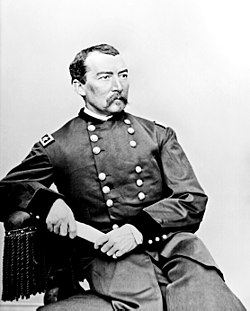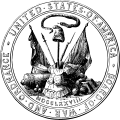1864
On May 21, 1864, Major General David Hunter was appointed to command the Department of West Virginia. Hunter designated the field forces of his department the "Army of the Shenandoah". Hunter was in command of the Army of the Shenandoah from May 21 to July 3 [3] which consisted of two infantry divisions and two cavalry divisions. The First and Second Infantry Divisions were commanded by Brigadier Generals Jeremiah C. Sullivan and George Crook respectively. The First and Second Cavalry Divisions were commanded by Brigadier Generals Julius Stahel (succeeded by Alfred N. Duffie) and William W. Averell respectively. In May Crook's and Averell's divisions fought independently at the battle of Cloyd's Mountain. Hunter personally led Sullivan's and Stahel's divisions at the battle of Piedmont. All four divisions were joined for the battle of Lynchburg. On July 3, George Crook assumed command of both infantry divisions and designated this as a new field army named the Army of the Kanawha. [4]
The force was next created by order of Ulysses S. Grant on August 1, 1864, in response to a raid by Jubal Early and his Confederate army of 15,000 on Washington, D.C., and especially his defeat of Lew Wallace at the Battle of Monocacy Junction. The new Army of the Shenandoah was composed of the Union VI Corps (commanded by Horatio G. Wright), XIX Corps (William H. Emory), and George Crook's Army of West Virginia (VIII Corps). It was placed under Sheridan's command with orders to repel Early, deal with Confederate guerillas, and press on into the Shenandoah Valley in Virginia.
Early, ever the cunning strategist, kept his force moving so as not to be trapped by Sheridan's vastly superior force. His raid had, if anything, a good deal of success for southern morale. Confederate General Robert E. Lee, coming to the conclusion that Early had done all that was practical, ordered Early to return two of his divisions to Richmond and remain to tie up Sheridan. Learning of this, Sheridan waited until Early weakened himself and then attacked at the Third Battle of Winchester on September 19 and then again at the Battle of Fisher's Hill on September 20–21. By the end of these battles, Early's force was effectively out of the war, and Sheridan proceeded with his secondary orders to destroy the ability of the Shenandoah Valley to produce foodstuffs for the Confederacy, torching farms and more than 2,000 mills.
Reinforced again in reaction to the threat of Sheridan's 31,000-man army, Early moved against Sheridan once more. After a decisive cavalry victory by Union forces under Brig. Gen. George Armstrong Custer at the Battle of Tom's Brook, Early's army launched a surprise attack against Sheridan at the Battle of Cedar Creek on October 19. Initially successful, the Confederates were repelled by a Union counterattack and the Valley was firmly under Union control.
Following those battles in the fall of 1864, the majority of the Army of the Shenandoah was detached to Grant at Petersburg and to William Tecumseh Sherman in Georgia. Sheridan joined Grant for the Appomattox campaign where Sheridan commanded the Army of the Shenandoah, which included two divisions of cavalry commanded by Wesley Merritt. In late April 1865, command of the army then passed to Brig. Gen. A. T. A. Torbert until July 12, 1865, when the force was disbanded for the final time.

